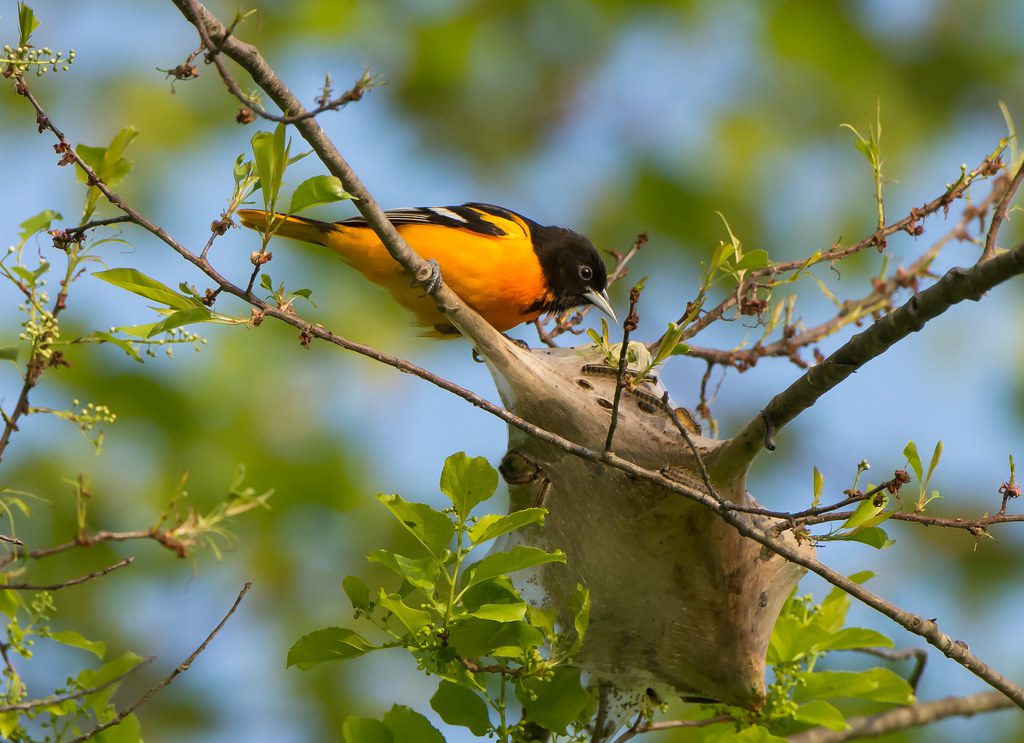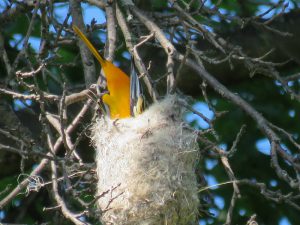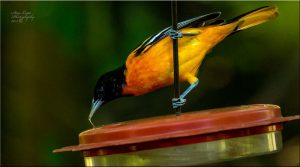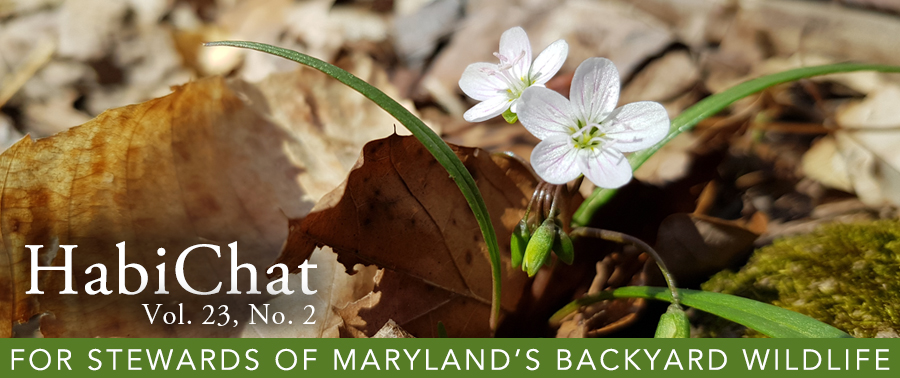Native Animal Profile: Baltimore Oriole

A male Baltimore Oriole inspects a tent caterpillar web; by Bonnie Ott
With striking orange and black plumage, it is no wonder why the Baltimore Oriole was selected as Maryland’s state bird. The male’s colors resemble the coat of arms for Sir George Calvert, First Lord of Baltimore.
Baltimore Orioles are medium-sized birds. Male Baltimore Orioles are flame orange and black with a solid black head and orange sides, with orange in the tail. Females and immature Baltimore Orioles are brown above and burnt orange below with two white wing bars. Many adult females have traces of black on their head, suggesting the hood of a male.
Baltimore Orioles can be found throughout Maryland in spring and summer months, though they are not as common on the coastal plain. In the winter, most Baltimore Orioles travel down to central and South America. Despite the male’s bright plumage, they are rarely seen. Baltimore Orioles prefer to nest in woodland edges, along river banks and in small groves of trees. They often spend much of their time in the tops of trees and can sometimes be found in deep forest.
In the treetops, Baltimore Orioles forage on multiple food items ranging from insects to plants. Baltimore Orioles feed upon caterpillars, beetles, scale insects, sawfly larvae and grasshoppers. They also have a penchant for consuming both eastern tent caterpillars and fall webworms which are often available to fuel peak migration. Preferred food trees and shrubs include serviceberry, apple, mulberry, cherry, blueberry, American mountain ash and blackberry.

Baltimore Oriole building a nest; by Synspectrum, Flickr CC by 2.0
In Maryland, Baltimore Orioles generally begin nesting in early June through mid-July. Males will court females by hopping around and showing off their plumage. Favorite nest and shelter trees include maples, sycamore, birches, apples, black cherries and oaks. Their nests are carefully woven by the female into hanging pendants. The nest is usually 3 to 4 inches deep with a small 2 to 3 inch wide opening on top, and a bottom chamber that is 3 to 4 inches across. Females will use a multitude of nesting materials – both artificial and natural. Some materials include grass, grapevine bark, wool, horsehair, cellophane, twine or fishing line. Unfortunately, some of the artificial nesting materials, like fishing line, can be a hazard to nesting orioles. Generally, it takes about a week for the female to build the nest, and she soon will lay 3-7 eggs on a soft layer of materials in the bottom chamber. The eggs take up to two weeks in incubate, and the nestlings take another two weeks to grow until they fledge.
Often, Baltimore Orioles are heard more than they are seen. The males have a flutelike call that consists of a short series of paired notes that are repeated 2–7 times and last 1–2 seconds each. Females also sing but in much shorter durations. Sometimes, the mated pairs will sing together.
During this time of year, Baltimore Orioles can sometimes be enticed to backyards with fruit offerings. Apples, grapefruits, oranges and bananas can appeal to Baltimore Orioles that are passing through. Sometimes grape jelly will also attract Baltimore Orioles, but it often is appealing to ants too. Fruit and jelly should be replaced every two days and feeders should be cleaned to prevent the buildup of harmful bacteria. Occasionally, Baltimore Orioles will drink from hummingbird nectar feeders. If you are fortunate enough to have habitat that would support nesting Baltimore Orioles, plants like black cherry, blueberry, serviceberry, red mulberry, raspberries and blackberries are attractive for their dark colored fruits. Maples, sycamore, birches, apples, black cherry and oaks also make good nesting trees, particularly if planted near wetlands.

Baltimore Oriole at feeder; by Stan Lupo, Flickr CC by NC ND 2.0
Unfortunately, Baltimore Oriole populations in Maryland and in the United States have been on the decline. In Maryland, there has been a 1.6 % decline per year since 1980. The loss of favored tree species like elms to Dutch elm disease may be part of a reason for decline. Langham et al. (2015) also found that with current climate predictions, southern sections of Maryland may become unsuitable for Baltimore Orioles.
References:
Baltimore Oriole Life History. 2019. Cornell Lab of Ornithology, All About Birds. https://www.allaboutbirds.org/guide/Baltimore_Oriole/overview Accessed: April 7, 2019.
Ellison, W.G. 2010. Second Atlas of the Breeding Birds of Maryland and the District of Columbia. Baltimore, MD: The Johns Hopkins University Press. 520 pages.Langham, G. M., J. G. Schuetz, T. Distler, C. U. Soykan, and C. Wilsey. 2015. Conservation Status of North American Birds in the Face of Future Climate Change. PLOS One. https://doi.org/10.1371/journal.pone.0135350
Happy Spring HabiChat fans!
Spring has officially sprung in Maryland. The migratory birds, like warblers, are currently making their way through our forest. Early nesting bee species are emerging from their nests and are pollinating spring wildflowers. Young wildlife can be seen in the garden. I’m so excited for all of the spring phenomena at play!
In this edition of HabiChat, learn about our native spicebush and the beautiful lepidoptera it supports, as well as a little more information about our state bird, the Baltimore Oriole. This edition will also focus on ways to rethink spring by embracing some of our early flowering native plants. Finally, this HabiChat will introduce you to a couple of books that might be of interest for enhancing your backyard wildlife habitat.
Spring is such a busy time in our gardens. If you are interested in making your garden more pollinator friendly, check out the Spring 2015 HabiChat issue. In addition, keep in mind that young wildlife will begin to be a common sight in backyards. Last year’s Spring HabiChat focused on bird-safe windows and deer resistant plants for pollinators. Check out our page, Think Twice Before Rescuing Young Wildlife, to learn about best practices when it comes to young animals.
As a final note, the University of Maryland Extension is holding a General Forestry Course for Maryland landowners. The goal of the course is for the landowner to design a forest stewardship plan framework for their property. The course covers all aspects of forests and forest management. Registration opens June 1 and the course runs from Sept 1 to Dec 15. The cost is $150. For more information, please visit the University of Maryland Extension site.
Happy Habitats,
Kerry Wixted
Click here to have HabiChat—the quarterly backyard wildlife habitat newsletter from the Wild Acres program—delivered right to your inbox!
In this Issue
Native Animal Profile: Baltimore Oriole
Native Plant Profile: Spicebush
Habitat Tips: Rethinking Spring with Native Plants
Habitat Tips: Books for Backyard Wildlife Gardeners


 1-888-373-7888
1-888-373-7888 233733
233733